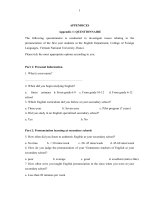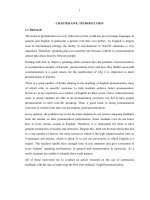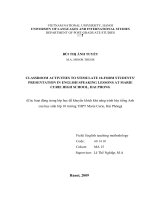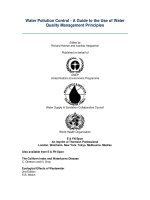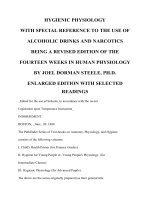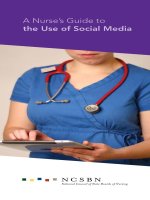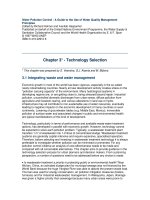An investigation in to the use of audio visual aids in speaking lessons at le thuy high school
Bạn đang xem bản rút gọn của tài liệu. Xem và tải ngay bản đầy đủ của tài liệu tại đây (946.74 KB, 101 trang )
MINISTRY OF EDUCATION AND TRAINING
VINH UNIVERSITY
----------------------
MAI THI LUONG
AN INVESTIGATION IN TO THE USE OF AUDIO-VISUAL
AIDS IN SPEAKING LESSONS AT LE THUY HIGH SCHOOL
MASTER’S THESIS IN EDUCATION
Nghe An, 2019
MINISTRY OF EDUCATION AND TRAINING
VINH UNIVERSITY
----------------------
MAI THI LUONG
AN INVESTIGATION IN TO THE USE OF AUDIO-VISUAL
AIDS IN SPEAKING LESSONS AT LE THUY HIGH SCHOOL
Field: Theory and Methodology of English Language Teaching
Code: 8.14.01.11
MASTER’S THESIS IN EDUCATION
Supervisor: Assoc. Prof. Dr. LE PHAM HOAI HUONG
Nghe An, 2019
i
STATEMENT OF AUTHORSHIP
I hereby acknowledge that this study is mine. The data and findings discussed
in the thesis are true and have not published elsewhere.
Author
Mai Thi Luong
ii
ABSTRACT
Speaking is one of the crucial skills in second language that should be
mastered by students at school and in daily life. The purpose of this study was to
explore the use of audio-visual aids in English speaking lessons at Le Thuy high
school. The study employed both quantitive and qualitative research methods.
Questionnaire, interview and classroom observation were used as tools of data
collection. The population of this study included teachers and students at Le Thuy
high school. Ninety students were invited to answer questionnaire. Besides, ten
teachers and ten students were directly interviewed. The findings show that generally,
the students had positive perceptions towards the use of audiovisual aids to learn
speaking skill. A lot of audio-visual aids were being effectively used at Le Thuy high
school. Types of audio-visual aids were used a lot in speaking lessons such as video
clip, pictures, hand-outs, powerpoint. However, certain difficulties such as
background knowledge, school facility, psychological factors, the quality of audiovisual aids and other factors are obstacles to teachers and students in using audiovisual aids. From the findings, the research has sought to provide practical
implications for improving students’ perceptions towards the use of audio-visual aids.
The use of the audio-visual aids can help teachers to develop their students' speaking
skill and and overcoming obstacles that teachers and students have when using audiovisual aids.
iii
ACKNOWLEDGEMMENTS
During the period of learning and researching the scientific research thesis “An
investigation into the use of audio-visual aids in speaking lesson in Le Thuy high
school”. I received support and assistance as well as caring and encouragement from
colleagues and students. Scientific research is also completed based on the reference,
learning experience from relevant research results, specialized books and newspapers
of many authors at universities.
First of all, I would like to express my deep gratitude to my supervisor- Assoc.
Prof. Dr. Le Pham Hoai Huong, who has always spent a lot of time and effort to
guide me throughout the process of researching and completing research topics.
I wish to send my appreciation to my dear teachers of Department of Foreign
Languages, Vinh University who taught to me in all the subjects which I have
participated.
My thesis would not have come to a completion without the help from my
students and colleagues who participated in my survey with their eagerness and
constructive ideas. I am grateful to my leaders of Le Thuy high school who gave me
favourable conditions during my study.
I would like to show my deep gratitude to my beloved family-my parents,
brothers, my friends, and especially my husband and two sons who shared all of the
ups and downs of my academic endeavours with their boundless love and continuous
support-both materially and spiritually.
iv
CONTENTS
STATEMENT OF ARIGINAL AUTHORSHIP……………………………
i
ABSTRACT……………………………………….………………………..
ii
ACKNOWLEDGEMENTS…………………………………………………
iii
TABLE OF CONTENT…………………………..…………………………
iv
LIST OFABBREVIATIONS……………………..…………………………
viii
LIST OF TABLES…………………………………………………………...
ix
LIST OF FIGURES………………………………….………………………
x
CHAPTER I
INTRODUCTION………..……...……………...
1
1.1. Rationale…………………………………………………………..…….
1
1.2. Research objectives………………………………………..…………….
3
1.3. Research questions………………………………………………………
3
1.4. Significance of the study………………………………………………...
3
1.5. Scope of the research…………………………………………..…..……
4
1.6. Structure of the thesis…………………………………………………...
4
LITERATURE REVIEW ……………………
6
2.1. Review of previous studies ……………………………………………..
6
2.1.1. In other countries…………………………………………….……….
6
2.1.2. In Vietnam……………………………………………………………
8
2.1.3. Gaps in literature……………………………………………….……...
9
2.2. Definitions of speaking……………………………………………..…..
9
2.2.1. Communicative competencies……………………………………….
9
2.2.2. Elements of Speaking ……………………………………………….
11
2.2.3. Factors that cause speaking difficulties to EFL Learners……………
12
2.3. Over-view of audio-visual aids………………………………………….
14
2.4. Definitions of audio- visual aids……………………………………....
15
2.5. Classification of audio-visual aids………………………………………
16
CHAPTER II
v
2.5.1. Audio aids…………………………………………………………….
16
2.5.2. Visual aids……………………………………………………………
18
2.5.3. Audio visual aids…………………………………………………….
21
2.6. Advantages of audio-visual aids in speaking lessons ………………….
23
2.6.1. Using audio visual- aids to improve students’ pronunciation……….
23
2.6.2. Using audio visual- aids to provide vocabularies…………………….
24
2.6.3. Using audiovisual- aids as a source of information…………………..
25
2.6.4. Using audiovisual- aids to motivate students’ attention………………
25
2.6.5. Using audio-visual aids to improve fluency………………………….
25
2.7.Disadvantages of audio-visual aids in speaking lessons………………..
27
2.7.1. Technical Problems…………………………………………………..
27
2.7.2. Student Distractions…………………………………………………..
27
2.7.3. Expenses……………………………………………………………...
28
2.7.4. Time………………………………………………………………….
28
2.7.5. Space…………………………………………………………………
28
2.7.6. Convenience………………………………………………………….
28
2.8. Summary……………………………………………………………….
28
CHAPTER III RESEARCH METHODOLOGY……………………….
30
3.1. Research approach………………………………………………………
30
3.2.1. Participants ……………………………………………………………
31
3.2.2. Survey participants……………………………………………………
31
3.2.3. Interview participants ………………………………………………...
31
3.2.4. Observations………………………………………………………….
32
3.3. Instruments for data collection………………………………………….
32
3.3.1. Questionnaire………………………………………………………….
32
3.3.2. Interviews……………………………………………………………..
33
3.3.3. Classroom observations………………………………………………
34
vi
3.4. Data analysis…………………………………………………………….
34
3.5. Summary………………………………………………………………...
35
CHAPTER IV
FINDINGS AND DISCUSSION………………………
36
4.1. Students’ perception of the use of audio-visual aids in speaking lessons
36
4.1.1. Students’ attitude towards the use of audio-visual aids in getting ideas
37
for English speaking………………………………………………………..
4.1.2. Students’ confidence in speaking with the use of audio-visual aids…..
38
4.1.3. Vocabulary learning with the use of audio-visual aids in speaking
39
lessons……………………………………………………………………….
4.1.4. Students’ positive attitude in class with the use of audio-visual aids…
40
4.1.5. The use of cartoons to improve pronunciation…………………..........
40
4.2. The use of audio-visual aids in English speaking lessons………………
45
4.2.1. Types of audio-visual aids used in speaking lessons………………….
45
4.2.2. Teacher’s activities in speaking lessons with the use of audio-visual
47
aid…………………………………………………………………………..
4.2.3. Students’ activities in speaking lessons with the use of audio-visual
48
aids…………………………………………………………………………..
4.3. Difficulties with the use of audio-visuals aids in speaking lessons……..
54
4.3.1. The difficulties faced by teachers in using audio-visual aids…………
55
4.3.2. Classroom size………………………………………………………...
56
4.3.3. Timing…………………………………………………………………
57
4.3.4. Noise…………………………………………………………………..
57
4.3.5. Speakers’ speed in audio materials……………………………………
58
4.3.6. The quality of audio-visual aids ………………………………………
59
4.4. Conclusion………………………………………………………………
64
CHAPTER V CONCLUSION AND IMPLICATIONS …………………
66
5.1. Summary of the findings………………………………………………
66
vii
5.1.1. Students’ perceptions towards the use of audio-visual aids………….
66
5.1.2. Audio-visual aid used in speaking lessons……………………………
67
5.1.3. Difficulties in using audio-visual aids………………………………..
67
5.2. Contribution of the research…………………………………………….
68
5.3. Pedagogical implications………………………………………………..
68
5.3.1. For administrators……………………………………………………..
68
5.3.2. For teachers……………………………………………………………
69
5.3.3. For students……………………………………………………………
70
5.4. Limitations………………………………………………………………
70
5.5. Further research…………………………………………………………
71
REFERENCES………………………………………………………………
72
APPENDICES……………………………………………………………….
78
APPENDIX I: QUESTIONNAIRE FOR STUDENTS……………………..
78
APPENDIX II: INTERVIEW QUESTIONS FOR TEACHERS……………
82
APPENDIX III: INTERVIEW QUESTIONS FOR STUDENTS…………..
83
APPENDIX IV: CLASSROOM OBSERVATION SHEET………………
85
APPENDIX
V:
SAMPLE OF
TRANSCRIPT
BY
TEACHERS’
INTERVIEW………………………………………………………………..
APPENDIX
IV:
SAMPLE OF
TRANSCRIPT
BY
87
STUDENTS’
INTERVIEW……………………………………………………………….
88
viii
LIST OF ABBREVIATIONS
CLT: Communicative Language Teaching
CDs: Compact disks
DVDs: Digital Video Disk
EFL: English as a Foreign Language
L1: The First Language
TV: Television
VCRs: Video Compact Records
ix
LIST OF TABLES
Table 4.1. Types of audio-visual aids in speaking lessons
Table 4.2. Teacher’s activities in speaking lessons with the use of audio-visual aids
Table 4.3. Students’ activities in speaking lessons with the use of audio-visual aids
Table 4.4. The factor of time in using the audio-visual aids
x
LIST OF FIGURES
Figure 4.1. Students’ attitude towards the use of audio-visual aids in getting
ideas for English speaking
Figure 4.2. Students’ confidence in speaking with the use of audio-visual aids
Figure 4.3. Students’ vocabulary learning with the use of audio-visual aids in
speaking lessons
Figure 4.4. Students’ positive attitude in class with the use of audio-visual aids
Figure 4.5. The use of cartoon to improve pronunciation
Figure 4.6. The difficulties faced by teachers in using audio-visual aids
Figure 4.7. The size of the classroom in learning speaking lessons
Figure 4.8. The effect of noise on listening audio-visual aids
Figure 4. 9. Speakers’ speed in audio materials
Figure 4.10. The quality of audio-visual aids
1
CHAPTER I
INTRODUCTION
1.1. Rationale
Language is considered
our primary source of communication. It is the
method through which we share our ideas and thoughts with others. Some people
even say that language is what separates us from animals and makes us human.
“Communication is the heart of every organization. Everything you do in the
workplace results from communication” (Taylor, 2018. p.102). We have been living
the international integrating time with a great number of changes in many fields from
economy, politics, science, technology to education. Naturally, such changes have
directly impacted upon English teaching and learning in many countries over the
world, including Vietnam. English is regarded as a link to express meanings, ideas,
and thoughts and strengthen the relationship among countries in the world. It has
become an essential communicative tool between the peoples of different nations in
most areas of our lives.
Nowadays, English is one of the compulsory subjects taught in educational
institutions from junior high school to university. Since the early 1960s, the English
language teaching has been subjected to tremendous changes. Proficiency in any
foreign language requires mastering the four language skills which are listening,
speaking, reading and writing. Speaking means negotiating intended meanings and
adjusting one’s speech to produce the desired effect on the listener (O’Malley (1996.
p59). Moreover, speaking is considered as the foundation for other skills. However,
speaking is a difficult skill to be mastered because ''there is a lot more to speaking
than the ability to form grammatically correct sentences'' (Harmer, 2005, p.iv). Many
useful techniques are given to improve speaking skill, audio- visual aids is one of the
effective communicative materials.
2
Today’s English classroom has gained a great attention to the use of various
audio-visual programmed in its teaching/learning process. It is a well-known fact that
various audio-visual materials as sources of authentic language input are a great help
in stimulating and facilitating the learning of a foreign or second language. Therefore,
teachers should use different materials and teaching aids in their classes in order to
provide more situations and activities for students to strengthen their speaking
competence. The integration of the audio-visual aids such as videos and films
provides exposure to the spoken language such as dialogues, plays, stories, interviews
as well as they are very important since they give students the opportunity to see and
to hear the foreign language in its real use. To develop students' speaking proficiency,
teachers should have the right choices of such materials. Furthermore, all audiovisual aids affect positively the student's speaking skill.
I have observed that many students at Le Thuy high school have difficulties to
communicate appropriately when using English. There are opportunities to speak
English inside and outside the classroom. In addition to the limited exposure to
English native speakers may be the reasons behind the students’ inability to speak.
The reasons for these difficulties are: Speaking has become one of the language skills
that is difficult to be mastered by the learners. Some students feel unconfident in
expressing their ideas orally. It is caused by many factors; for example, they are
afraid of making mistakes in pronunciation and choosing the appropriate words, the
other factor are lack of vocabularies and grammar. Another reason is, the method is
inappropriate. The teacher gives lectures, asks students to take notes, gives students
homework and asks you to study. He talks all the time the lessons are sometimes
boring and there must be something wrong with the method. “Listen and repeat” has
never been an effective learning method. You need to combine speaking with other
skills and apply what you have learnt in real-life situations. Furthermore, although the
use of audio-visual aids in language teaching has become a common fashion for the
language teachers, many of them might not be well aware of the effectiveness of
3
these. This study will give an insight to the language teachers of using audio-visual
aids in facilitating language skills of the learners. Therefore, teachers should provide
more activities and use different teaching aids to strengthen their students’ speaking
competence. Using materials such as audio tapes, videos, videotapes, posters,
pictures, power-point slide etc. in the classroom will facilitate the teaching and
learning process and allow the students to get more information about grammar,
vocabulary, pronunciation and intonation. That is the reasons why I decided to carry
out a research “An investigation into the use of audio-visual aids in speaking
lessons at Le Thuy high school”.
1. 2. Research objectives
With the reasons mentioned above, this paper aims:
- To study the perception of students of the use of audio- visual aids in learning
speaking skill
- To find out the ways of using audio- visual aids in English speaking lessons
- To explore possible problems that students and teachers have in teaching and
learning speaking skill when using the audio-visual aids. From that teachers and
students can find out the right solutions to improve the speaking skill.
1. 3. Research questions
1. What are students’ perceptions of the use of audio-visual aids in speaking lessons?
2. How are the audio-visual aids being used in English speaking lessons?
3. What are some difficulties with the use of audio- visual aids in speaking lessons?
1. 4. Scope of the research
This research was restricted to investigate the use of audio-visual aids in speaking
lessons. The study was carried out at Le Thuy high school, Le Thuy district, Quang
Binh province with 10 teachers and 90 11th grade students at 2 random classes at this
school during the school year 2018-2019.
4
1. 5. Significance of the study
This research aims at investigating students' perceptions towards the importance of
audio-visual aids as well as examining the ways of using audio-visual aids and
difficulties that students and teachers face when they using audio-visual aids. It is
hoped that the findings of this study has both theoretical and practical significance.
Theretically, this study, explores the role of the audio-visual materials in providing
exposure and knowledge about the foreign language to help students in developing
the speaking skill. Practically, from this study we can find out the perception of
students at Le Thuy high school to the use of audio visual aids in speaking lessons,
how audio-visual aids are used and possible problems when using audio-visual aids.
Finally teachers can determine useful strategies for using audio- visual aids in using
audio-visual aids at Le Thuy high school. As a result, this study will be a future
guideline for the English language teachers.
1.6. Structure of the thesis
Chapter One: Introduction
This chapter presents the introduction of study, which includes the rationale, aim and
objectives, research questions, significance as well as the structure of the thesis.
Chapter Two: Literature review and theoretical background
This chapter is devoted to the review of the previous related studies and then shows
the theoretical background of the study.
Chapter Three: Methodology
The research methods, data collection, data analysis and research procedures of the
study are described in this chapter.
Chapter Four: Findings and discussions
This chapter elaborates the findings of the study, including views of students on
learning Speaking skill, instructional strategies are often used and some difficulties
the students meet in learning speaking skill. Finally, the suggestions of strategies are
5
efficient and effective to improve speaking skill.
Chapter Five: Conclusion and implications
This chapter gives a summary of the major findings, suggests some implications and
also suggestions for a further research.
6
CHAPTER II
LITERATURE REVIEW
Introduction
This chapter presents the previous research works in other countries and in
Vietnam and findings related to the use of audio-visual materials to teach speaking
skill. Besides, it discusses the concept of audio-visual materials, types of audio-visual
materials, the use of audio-visual aids in English speaking lessons is one of the
focuses. It also deals with advantages and disadvantages of audio-visual aids when
used in English speaking lessons.
2.1. Review of previous studies
2.1.1. In other countries
This thesis deals with the use of audio-visual aids in speaking lessons. In
reality, there are some studies which were related audio-visual aids in our region and
in the world. Adullahal Mamun (2011) had a research on “Effectiveness of audiovisual aids in Language Teaching in Tertiary Level” at BRAC University, Dhaka”. It
investigated how the language teachers, as well as learners, were benefited from the
audio-visual aids in language teaching and learning. This research provides a clear
view of the reasons of using audio-visual aids in language teaching and its advantages
from both teachers’and learners’perspectives. The research found that both the
teachers and the students showed favorable attitude toward the use of audio-visual
aids agreeing that they facilitated language teaching and learning in diverse ways. By
using audio visual aids in the classroom, teachers can teach languages making the
class more interesting. Different visuals brought variation in the classroom teaching
which were helpful to draw the attention of the students toward the lessons. Another
research by Mizab Meriem (2015) on “The role of audio-visual aids in enhancing
EFL students’speaking skill”. The study investigated the role of audio-visual aids in
helping students to overcome the difficulties to enhance their speaking proficiency of
the first year students of English at Biskra University in People’s Democratic
7
Republic of Algeria. The study found that the use of audio-visual aids was very
helpful in developing students' speaking abilities. These tools provided them with an
important exposure to the authenic foreign language to know about the right way of
using English in communication. Moreover, they mentioned different kinds of audiovisual aids such as computer, internet, television and video which could motivate
students and creat a relaxed classroom atmosphere for better learning. A study was
investigated by Siti Rahmah (2014) about “The effectiveness of poster presentation in
teaching speaking to the seventh graders of Ketangga in the school year 2013-2014”.
This study aimed at knowing whether or not there were effectiveness of poster
presentation and and the extent of poster presentation in teaching speaking to the
seventh graders of Ketangga in the school year 2013-2014. Through this study can y
provide many new insights in studying speaking skill especially about teaching
speaking using poster presentation, develop the quality of teaching learning process
in focusing those processes on students’ activity, enhance their strategies in teaching
and learning process and facilitate students to speak in English well so that speaking
skills are not difficult anymore. Another study was conducted by Rahmawati (2016)
about “The use of audio-visual aids as a media to improve students’ listening skill” at
University of Muhamadiyah. The objective of this study was to provide an overview
of the implementation of audio visual as a media in the teaching and learning process,
providing an overview of the effectiveness of using audio visual as a media in
students’ listening skill and providing an overview about the advantage effectiveness
of using audio visual as a media in students’ listening skill. Besides, there was a study
of challenges facing teachers and students in the use of instrcutional technologies: A
case of seclected secondary schools in Kisii County, Kenya. This study aimed at
finding out the challenges of using instructional technologies: what resources were
available, Whether or not the resources were adequate, their accessibility,
interactivity and use of instructional technologies between the teachers and students,
school organization policy on use of instructional technologies, novelty of the
8
instructional technologies and trendiness on use. Based on the findings of the study,
the researcher has made suggestions on improving the use of instructional
technologies in teaching and learning process.
2.1.2. In Vietnam
In Hue University of Foreign Languages, there were also some studies which
were carried out related to the use of audio-visual aids. Ngo (2004) had a research on
“Possibilities of using audio-visual aids to support teaching and learning ESP lessons
in cultivation at Hue College of Agriculture and Forestry”. The research worked out
with the purposes to identify possibilities of using audio visual aids to support
teaching and learning ESP lessons in cultivation at Hue College of Agriculture and
Forestry. This research also gave a sample ESP lessons in cultivation using audio
visual aids and suggested ways to teach sample lessons effectively. The findings of
the research shown the using audio-visual aids in ESP classes was necessary because
students could be more motivated and the lessons could be more interesting. It could
get students to be actively involved in their learning, but facilities available were not
enough for them to carry out what they want. Time consuming also made it difficult
to apply audio-visual aids into language teaching. Another study by Ho (2011) had a
research on “An action research on the use of audio-visual aids in teaching English
vocabulary in grade 6 at Ham Nghi Junior high school- Hue city”. The research
investigated the effectiveness of using audio-visual aids in teaching vocabulary for
grade 6 students. The findings of the research shown that students learning
vocabularies were able to remember word meaning better when using pictures,
realties, gestures, mining in present vocabularies. Students could memorize word
spelling better when participate in games. Besides, students could improve word
pronunciation when using color chalk to notice word stress and CD player to get
them acquainted with native speakers’ voice.
9
2.1.3. Gaps in literature
All of the above studies focused on some aspects of audio-visual aids. They
only mentioned the role of audio-visual aids, the possibilities of using audio- visual
aids and the use of audio-visual aids in teaching vocabulary. Moreover, they focused
on the effectiveness of audio-visual aids. As you know, nowadays, with the
development of technology, the use of modern technology, especially audio-visual
aids, makes teaching and learning more effective. However, besides the above
studies, I hope this thesis will gain a deeper understanding of the importance and
meaning of audio-visual aids in English learning process and make an investigation
into students’ perceptions, the use of audio visual aids in speaking lessons and
difficulties of using audio visual aids in speaking lessons at Le Thuy high school.
2.2. Definition of speaking
Speaking is defined as an interactive process of constructing meaning that
involves producing, receiving and processing information. Its form and meaning are
dependent on the context in which it occurs, the participants, and the purposes of
speaking (Burns & Joyce, 1997). Speaking is defined operationally in this study as
the secondary stage students' ability to express themselves orally, coherently, fluently
and appropriately in a given meaningful context to serve both transactional and
interactional purposed using correct pronunciation, grammar and vocabulary and
adopting the pragmatic and discourse rules of the spoke language. In other words,
they are required to show mastery of the following sub competencies/ skills:
2.2.1. Communicative competencies
Hymes (1985, p. vii) define communicative competence as " what speaker
needs to know to communicate effectively in culturally significant setting." ( As
cited in Paulston, 1992, p.97). Renandya and Richards (2002, p.206-208) state that
mastering the speaking skill is a complex task because it requires more than learning
the foreign language grammatical rules. However, students must know how native
speakers use the foreign language in different context. Based on Hymes's theory,
10
Canale and Swain (1980) proposes a communicative competence model which
consists of different components including: gramatical competence, discourse
competence, sociolinguistic competence; in addition to strategic competence.
- Grammatical competence
Grammatical competence makes students use and understand English
language fluently. It includes grammare rules (morphology, syntax), vocabulary, and
mechanics ( which refers to basic sounds of letters and syllables, pronunciation, and
intonation). So for effective communication, students should know how to use these
rules in order to convey meaning.
- Discourse competence
Discourse competence refers to the ability to apply the rules of cohesion and
coherence to produce a meaningful spoken discourse for effective communication.
- Sociolinguistic competence
For effective use of the foreign language, students should not learn knowledge
of language only. They must also know what is socially and culturally appropriate in
the foreign language. In other words, students must know how to take a turn in
communication, how should they speak, politeness rules and all what is accepted in
the foreign language community.
- Strategic competence
Strategic competence is " the way learners manipulate language in order to
meet communicative goals" (Brown, 2004, p.228) and it is considered as the most
important communicative competence element. It refers to the speaker's abilities to
use different communicative strategies to compensate any break down in
communication.
- Fluency
Hedge (2000,p54) defines fluency as ‘‘The ability to link units of speech
together with facility and without strain or inappropriate slowness, or undue
hesitation’’. Faerch, Haastrup, and Phillipson add fluency as a component of
11
communicative competence and they make a distinction between it and strategic
competence. They mention that strategic competence ‘‘presupposes a lack of
(accessible) knowledge"; however, "fluency covers speakers' ability to make use of
whatever linguistic and pragmatic competence. So fluency is the ability to link
words and phrases, respond coherently in conversation, and clear sounds
pronunciation with stress and intonation quickly.( As cited in Hedge, 2000,p.54) In
short, speaking profeciency consists of different elements which should be
developed by the foreign language students since they may have any opportunities to
communicate with native speakers. So they should acquire different knowledge
about the native speaker's language to communicate appropriatly with them.
2.2.2. Elements of Speaking
The elements of speaking consist of utterance, grammar, vocabulary, fluency,
content, and comprehension (Brown, 2004). The present researcher will focus the
definition on aspects of utterance, vocabulary, grammar, content and meaning,
pronunciation and fluency.
- Utterance skill
The utterance skill is one of the important things in making a message
acceptable. Speaking is exchange of idea or thought about a certain topic between
two or more speaker. Greene and Petty (in Tarigan, 2008) state that speaking is
process of listening and responding simultaneously and spontaneously. Speaker
should be able to choose and use the words appropriateness of expression and
sentence, clear voice and a good intonation.
- Vocabulary
Hornby (1995) states that vocabulary is the total number of words in language.
Mastering a huge number of vocabulary will show how fluent is a speaker talk using
the language because speaking is an activity which need co
12
- Grammar
According to Harmer (2004) notes that grammar is the description of the way
in which word can change their form and can be combined into sentences in that
language. Creating a good grammatical sentence is very difficult. The grammar very
important role in understanding the speakers’ utterance.
- Content and Meaning
The content and meaning is ability in speaking which can be seen from
mistake, completeness, clarification, and simplicity what the topic about (Tarigan,
2008).
- Pronunciation
Pronunciation includes the pronunciation itself, stress, and intonation.
Fachrurrazy (2011) notes that pronunciation can be defined as the way a certain
sound or sounds are produced. Stress in the pronunciation of the word (in a sentence)
or syllable (in a word) with more force than the surrounding words or syllables.
Intonation is the rise and fall of the pitch of the voice in speaking, especially as this
affects the meaning of what is said.
- Fluency
In spoken language the question faced by the teacher is how they shall
prioritize the two clearly important speaker goals of accurate (clear, articulate,
grammatically and phonologically correct) language and fluent (following, natural)
language? It is now very clear that fluency and accuracy are both important goals to
purse in CLT Fachrurrazy 9 (2011). In Oxford dictionary, Hornby (1995) states that
fluent is able to speak a language easily and well.
2.2.3. Factors that cause speaking difficulties to EFL Learners
Zhang (2009) argued that speaking remains the most difficult skill to master
for the majority of English learners, and they are still incompetent in communicating
orally in English.According to Ur.P (1996), there are many factors that cause
difficulty in speaking:
Students are worried about making mistakes, fearful of
13
criticism, or simply shy. Students have no motive to express themselves. They have
nothing to say.
In addition, due to low or uneven participation. Only one participant can talk at
a time because of large classes and the tendency of some learners to dominate, while
others speak very little or not at all. Especially, learners often use mother-tongue.
They share the same mother tongue tend to use it because it is easier and because
learners feel less exposed if they are speaking their mother tongue.
In addition, Rababa’h (2005) pointed out that there are many factors that cause
difficulties in speaking English among EFL learners. Some of these factors are
related to the learners themselves, the teaching strategies,the curriculum, and the
environment. For example, many learners lack thenecessary vocabulary to get their
meaning across, and consequently, they cannot keep the interaction going.Inadequate
strategic competence and communication competence can be another reason as well
for not being able to keep the interaction going. Some learners also lack the
motivation to speak English. They do not see a real need to learn or speak English.
Actually, motivation is the crucial force which determines whether a learner
embarks in a task at all, how much energy he devotes to it, and how long he
preserves (Littlewood, 1984, p.53). The development of communicative skills can
only take place if learners have the motivation and opportunity to express their own
identity and
relate with the people around them (Littlewood, 1981). Teaching
strategies also contribute to this problem as they are inadequate, and they do not put
emphasis on speaking, which results in a meagre development of this skill. Besides,
vocabulary items are taught in isolation, and listening materials are not used by the
majority of schoolteachers because of the large number of teachers compared
with the number of cassettes available. Teacher-training programs were found
to be
not
very
successful
in
changing
the
teachers’ methodology
(Rababa’ah,2005). Furthermore, all the other subjects are in Arabic, and English is
seen as an academic subject only, which means exposure to the English language
